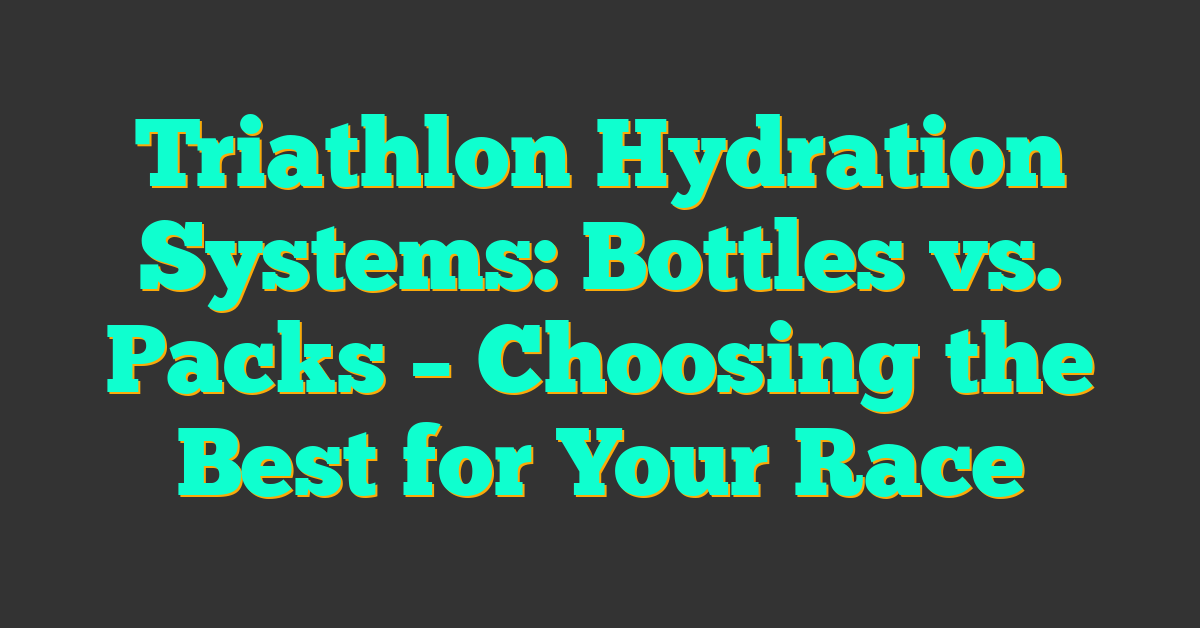Training for a triathlon means balancing swimming, biking, and running, and staying hydrated is crucial every step of the way. I’ve spent countless hours experimenting with different hydration methods to find what truly works best during those intense races.

Choosing between bottles and packs can feel overwhelming, but each has its perks. Bottles are simple and easy to use, perfect for quick sips on the bike. On the other hand, packs offer hands-free convenience and extra storage, which can make a big difference during long events.
In this article, I’ll dive into the pros and cons of each system, helping you decide which hydration method aligns with your triathlon goals and personal preferences. Let’s explore the best way to keep you fueled and ready to conquer your next race.
Overview of Triathlon Hydration Systems
Hydration systems keep my fluid levels steady during triathlons. I choose between bottles and packs based on race segments and personal needs.
Bottles
- Simplicity: Easy access and straightforward use.
- Capacity: Hold 16 to 24 ounces each.
- Placement: Attach to bike frames or handheld, allowing quick sips.
Packs
- Hands-Free: Integrated into cycling gear or backpacks.
- Additional Storage: Provide space for gels, keys, or tools.
- Capacity: Accommodate 16 to 28 ounces per pack.
Each system offers unique benefits, helping me maintain performance and comfort throughout the race.
Bottled Hydration Systems
Bottled hydration systems offer a straightforward solution for staying hydrated during triathlons. They are easy to manage across all three disciplines.
Advantages of Bottles
Bottles provide simplicity and accessibility. Holding 16 to 24 ounces, they attach to bike frames or fit comfortably in hand. Quick sips are possible without adjusting gear. Multiple bottle types cater to different preferences, including flip-top and bite valve options.
Potential Drawbacks
Bottles may require frequent refills, especially in longer events. Limited storage space restricts carrying additional essentials like gels or tools. Hand-holding bottles during runs can be cumbersome, potentially affecting performance.
Hydration Packs
Hydration packs provide a convenient way to stay fueled during triathlons. They integrate seamlessly into your gear, ensuring you remain hydrated without interrupting your flow.
Benefits of Packs
- Hands-Free Convenience: Enables focus on performance by eliminating the need to hold bottles.
- Integrated Storage: Offers space for gels, tools, and other essentials, keeping everything accessible.
- Capacity Range: Holds 16 to 28 ounces, accommodating various hydration needs for different race lengths.
Possible Limitations
- Added Weight: Increases overall load, which may impact speed and comfort.
- Bulkiness: Takes up more space on your gear, potentially causing discomfort during the run.
- Leak Risk: Possibility of spills if the pack isn’t securely fitted or properly maintained.
Performance Comparison
Comparing the performance of bottles and packs helps determine the best hydration system for triathletes.
Comfort and Mobility
I find bottles lightweight, reducing fatigue during cycling and running. They attach easily to bike frames, allowing quick access without hindering movement. Packs distribute weight evenly across my back, enhancing stability on long runs. However, improper fitting can cause discomfort, so adjustable straps are essential for maintaining comfort.
Hydration Capacity
Bottles typically hold between 16 and 24 ounces, providing sufficient hydration for standard race lengths. Longer events may require more frequent refills, potentially disrupting my flow. Packs offer a slightly larger capacity, ranging from 16 to 28 ounces, and include additional storage for gels and tools. This setup ensures I stay hydrated and fueled without pausing my performance.
Cost and Maintenance
When choosing between bottles and packs, cost varies significantly. Bottles typically range from $15 to $30 each, depending on features like insulation or valve type. Packs usually cost between $50 and $100, reflecting their additional storage and integrated systems.
Maintenance differs as well. Bottles require simple cleaning with soap and water, and most are dishwasher safe. Packs need thorough cleaning of reservoirs and tubes to prevent mold and bacteria. Regular inspections for leaks or wear are essential for packs to ensure longevity.
| Hydration System | Initial Cost | Cleaning Effort | Durability |
|---|---|---|---|
| Bottles | $15-$30 each | Low | High |
| Packs | $50-$100 | High | Medium |
Choosing bottles offers lower upfront costs and easier maintenance, while packs provide more storage at a higher price and maintenance commitment. Assessing your budget and willingness to maintain the system will guide the best choice for your triathlon needs.
Choosing the Right System
Selecting the appropriate hydration system depends on several factors specific to your triathlon goals and personal preferences.
Race Distance
For shorter races (sprint or Olympic distances), bottles typically suffice. They hold 16 to 24 ounces, providing enough hydration without adding extra weight. In longer events (half-Ironman or Ironman), packs offer a larger capacity of 16 to 28 ounces, ensuring sustained hydration throughout the race.
Storage Requirements
If you require additional storage for nutrition or tools, packs are the better choice. They accommodate gels, energy bars, and small tools, keeping your essentials within reach. Bottles, on the other hand, offer limited space, usually just for water or sports drinks.
Comfort and Fit
Comfort is crucial for maintaining performance. Packs distribute weight evenly across your body, reducing fatigue during long runs. Ensure the pack fits snugly to prevent chafing. Bottles remain lightweight and unobtrusive, allowing quick access without impacting your movement.
Budget Considerations
« How to Fuel a Triathlon Relay: Essential Nutrition Tips for Success
How to Train for Triathlon at High Altitude: Essential Tips & Strategies »
Bottles are more budget-friendly, ranging from $15 to $30. They require minimal maintenance and offer high durability. Packs cost between $50 and $100, reflecting their additional storage and functionality. Consider your budget and how often you participate in triathlons when making your choice.
Maintenance and Durability
Ease of maintenance influences long-term use. Bottles demand low cleaning effort and are highly durable, making them ideal for frequent use. Packs need thorough cleaning of reservoirs and tubes to prevent leaks and odors, increasing maintenance time.
Personal Preference
Ultimately, personal preference plays a significant role. Some athletes prefer the simplicity and lightness of bottles, while others value the hands-free convenience of packs. Experiment with both systems during training to determine which aligns best with your comfort and performance needs.
Summary
Choosing the right hydration system hinges on race distance, storage needs, comfort, budget, maintenance, and personal preference. Assessing these factors helps you select between bottles and packs, ensuring you stay hydrated and perform optimally during your triathlon.
Conclusion
Finding the right hydration system really changed how I tackled my triathlon training. Bottles offered simplicity and easy access, perfect for quick sips on the go.
On the other hand packs gave me the freedom to carry extra essentials without interrupting my flow. It was all about what felt best for me during each segment.
I encourage you to try both options and see which one matches your racing style. Staying hydrated can make all the difference in your performance and enjoyment.










